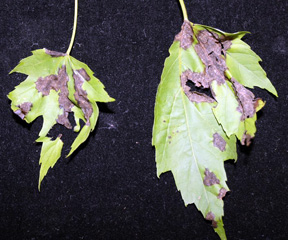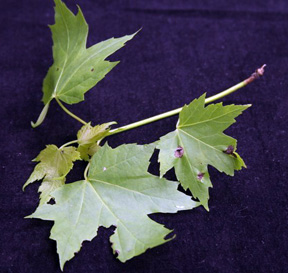Maple anthracnose
Editor’s note: This article is from the archives of the MSU Crop Advisory Team Alerts. Check the label of any pesticide referenced to ensure your use is included.
My
phone has been ringing a little more than usual this week with calls
about severe leaf spotting on maple, silver maple in particular. The
frequent spring rains coincided with leafing out on maples and they are
now heavily infected with maple anthracnose. The lesions are very dark
in color, so one might confuse the lesions with those caused by tar spot
(black tar spot lesions develop in late summer or early fall, so we
have that to look forward to). Surprisingly, I am not hearing about or
seeing much anthracnose on oak or sycamore.
Anthracnose is a fairly generic disease name, many different plants –
vegetables, perennials, annuals, trees, etc. get diseases commonly
referred to as anthracnose. When we talk about shade tree anthracnose,
we are referring to diseases caused by several different, but related
fungi. These pathogens blight foliage and in some cases create cankers
on twigs, resulting in dieback. Anthracnose foliar lesions are large,
irregularly shaped areas of necrotic tissue along the leaf margins and
between the veins. Leaf blighting typically begins on lower branches and
spreads upward. With a hand lens, you may be able to see the fungal
fruiting bodies along the veins of infected foliage.
Newly emerged foliage is more susceptible to infection. In general,
fungicides are not recommended for control of shade tree anthracnose.
Large well established trees that are otherwise healthy can withstand
the damage without serious long term affects. In time, severely infected
plants will push forth a new flush of growth from buds that would
otherwise have remained dormant. There are some situations where
chemical control is warranted. Some examples are protection of nursery
stock, smaller trees or trees that are not well established, or in “show
case” areas where for aesthetic reasons it is important to maintain a
disease-free tree. Applications of copper-based fungicides,
chlorothalonil, thiophanate-methyl, mancozeb, or Spectro will help
protect foliage from infection. Refer to the fungicide label for
application rates and intervals.
If you are not inclined to use fungicides to manage this disease,
remember that sanitation is also important. High humidity and rain help
spread spores to the newly emerging foliage. Fallen leaves should be
raked up and removed; spores of the pathogen remain viable on this dead
foliage even throughout the winter.
Maple anthracnose.





 Print
Print Email
Email

